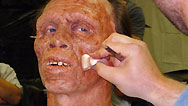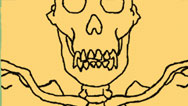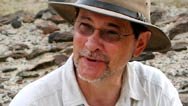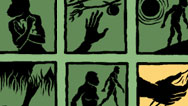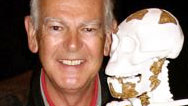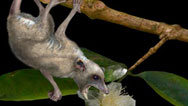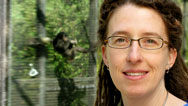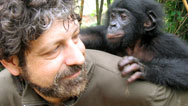
Becoming Human Part 1
First Steps: Six million years ago, what set our ancestors on the path from ape to human? Airing August 31, 2011 at 9 pm on PBS Aired August 31, 2011 on PBS
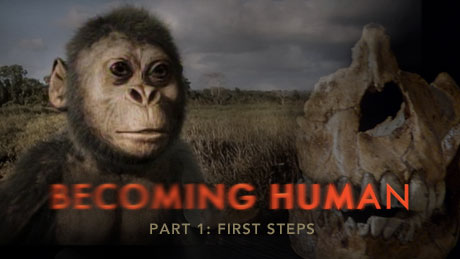
Program Description
Transcript
Becoming Human – Hour 1
PBS Airdate: November 3, 2009
NARRATOR: Humans: without a doubt, the smartest animal on Earth. Yet we're unmistakably tied to our ape origins. Millions of years ago, we were apes, living ape lives in Africa. So how did we get from that to this? What happened? What set us on the path to humanity?
The questions are huge. But at last, there are answers.
More than 6,000,000 years ago we took that first step to separate from the apes.
DONALD JOHANSON (Arizona State University, Institute of Human Origins): We see the launching of the career that ultimately led to Homo sapiens.
NARRATOR: And 3,000,000 years ago, we see the roots of our big brain begin to take hold in a tiny creature, more like a chimp than a human.
PETER DEMENOCAL (Columbia University, Lamont-Doherty Earth Observatory): The frontier of human evolution is really being brought to this razor-sharp edge.
NARRATOR: And we now know that for millions of years, many different human-like species lived together on the planet, until one day there was only us: Homo sapiens, the most complex, adaptable animal on Earth.
So how did we get this way and why?
A radical new theory reveals how episodes of cataclysmic change forced our ancestors to adapt or die.
MARK MASLIN (University College London): I think we should actually look to our proud ancestry and how we evolved in East Africa and say, "That's how we survived that. We can survive the future."
NARRATOR: So get ready for a ride through millions of years of our history. It's the story of Becoming Human—our story, right now on NOVA.
Major funding for NOVA is provided by the following:Natural gas is a cleaner-burning fuel, yet a lot of natural gas has impurities like CO2 in it. Controlled Freeze Zone is a new technology being developed by ExxonMobil to remove the CO2 from the natural gas so we can safely store it where it won't get into the atmosphere. ExxonMobil is spending more than $100 million to build a plant that will demonstrate this process. I'm very optimistic about it because this technology could be used to reduce greenhouse gas emissions significantly.
However you picture your retirement, Pacific Life can help, using 401(k) savings, life insurance and annuities to provide a dependable income for the rest of your life. With more than 140 years of experience, Pacific Life can help you achieve your vision of the future. Your financial professional can tell you more about Pacific Life: the power to help you succeed. And Merrill Lynch Wealth Management. You can learn more at ml.com/help2.And David H. Koch. And...
Discover new knowledge: HHMI.
And by the Corporation for Public Broadcasting and viewers like you. Thank you.
NARRATOR: Millions of years ago, on the plains of Africa, a momentous event took place. Apes that had walked on four legs stood up and walked on two. Eventually, this change in posture would be followed by a change in their brains. Somehow, over time, they would become us.
We know it happened, but we've never known when or why, until now.
In the Sahara desert, a 6,000,000-year-old fossil called Toumaí¯ may hold the secret of how we first walked upright.
MICHEL BRUNET (College de France): We're writing the first chapter of human evolution. We're very close to the beginning, very close.
NARRATOR: And the fossilized bones of a child from three and a half million years ago hint to us about the beginnings of human thought.
We're discovering how many different human species lived on Earth at the same time and why all but one died out.
We, Homo sapiens, are the first, ever, to be alone.
So what powered our evolution? Why did we become human? Scientists are scouring the most remote parts of Africa for clues.
The search for answers begins here, in the Afar, northeastern Ethiopia. It's part of the Great Rift Valley, a deep cut in the earth where geologic forces are ripping Africa apart.
Millions of years of history are brought to the surface in layers of exposed rock. It's hot and desolate; dangerous, too. Ancient rivalries and modern weapons have turned the Afar into a no-man's land of simmering conflict.
But Zeray Alemseged has made this forbidding place his life's work. He's searching for the fossilized traces of our earliest human ancestors.
The fossil bones of animals like antelopes, elephants and pigs are abundant. But the fossils of our ancestors are extremely rare. Then, in a stroke of luck, Zeray makes the find of a lifetime, a find that illuminates our origins in a unique way.
ZERESENAY ALEMSEGED (California Academy of Sciences): On that afternoon, we decided to survey this hillside, and the first thing that we spotted was a cheekbone of the face.
NARRATOR: It was a face so tiny, it had to be a baby. But not a baby chimp, he could tell that from its shape. The skull was embedded in sandstone, but as Zeray turned it over he could see more bones inside.
Everything was squashed against the base of the skull and completely covered by sandstone block.
Clues to the age of the fossil came from a distinctive feature in the landscape, white bands of volcanic ash.
ZERAY ALEMSEGED: And that is the volcanic ash, dated to 3.4 million years ago.
NARRATOR: If the volcanic ash is 3.4 million years old, Zeray's fossil, which was lying just above it, must be younger.
It was a child from the dawn of human evolution, about 3.3 million years ago.
Zeray called the baby Selam, the Ethiopian word for peace. Then he set off on a quest to unravel her many mysteries.
Her journey began a very, very long time ago.
Imagine the entire span of recorded human history, taking us back to the Egyptian pyramids, about 5,000 years. Double it: 10,000 years ago, when plants were domesticated and agriculture begins. Double it again, to the time when Ice Age hunters paint stunning images on cave walls.
And keep doubling, six more times, taking us back 1.3 million years, when the first creature who really looked like us hunted on the plains of Africa. And then keep traveling back another two million years, and only then do we arrive in the time when Selam lived in Ethiopia nearly three and a half million years ago.
What were Selam and her family like? What kind of world did they live in? The answers are hidden in their fossil bones.
Addis Ababa, Ethiopia, Zeray's home. He is one of a whole new generation of African scientists trying to unravel the mysteries of human origins.
Zeray has brought his precious fossil here to the national museum. His challenge is to release her from the tomb of sandstone in which her bones are encased.
He quickly identifies her. She's from a species considered by most scientists to be an ancient ancestor, Australopithecus afarensis: a small, chimp-like creature who walked on two legs.
This is the same species as the famous Lucy, discovered in the 1970s by Don Johanson.
DONALD JOHANSON: Lucy was terribly important because she was really an amalgam, and she...of, of different characteristics of ape and human.
ZERAY ALEMSEGED: I think specimens like Selam and Lucy are extraordinary, simply because you can look at them and see evolution in the making.
NARRATOR: But seeing "evolution in the making" will take some work. Selam's fossilized bones are solid rock held together by a mesh of soft sandstone. It has to be painstakingly removed.
ZERAY ALEMSEGED: We spent hours...hours and hours and days and years and years, and I removed the sand grains, grain by grain, working every day.
NARRATOR: He's been at it for eight long years, but the payoff has been amazing. As the work progressed, Zeray revealed an almost complete skull, and tucked beneath it was nearly her entire spine, along with both shoulder blades. Other bones were found nearby.
ZERAY ALEMSEGED: An almost complete foot. This is the kneecap...the tibia, here.
NARRATOR: Never before had a child's skeleton been found, so ancient and so complete. Her bones would fit in a shoebox, but they speak volumes about her life.
For example, to find out how old she was when she died, Zeray looked at her teeth. But not the baby teeth visible in her jaw: the adult teeth growing inside the bone, as seen in a CT scan. From that, we know Selam died at age 3.
Like Lucy, she testifies to a crucial step in our evolution.
Unlike apes, these creatures walked upright. As the first fossil Don Johanson found clearly revealed.
DONALD JOHANSON: It was sticking out of the ground like that. And I gently tapped it with my sneaker and this is what fell out of the ground. And it is the, this is your, the top end of your shinbone. So the kneecap would sit right in here. And very close by, in two pieces, I found this bone. And when you put them together, and you see how they move and articulate...and it has all the hallmarks of an upright person.
NARRATOR: Other bones confirm that Lucy walked on two legs like us.
DONALD JOHANSON: This is Lucy's pelvis. And in a...and you can see how different a chimpanzee is. And the reorientation of these hipbones: in a chimp they're facing straight forward, so here's...this is, this is what everybody is sitting on in their living room right now. So they're not identical, but clearly these two resemble each other much more closely, right, than either one of these resembles the pelvis of an ape.
NARRATOR: From the waist down, Lucy was like us. From the waist up, she and her kind were all ape.
Selam's skeleton is the same, with chimp-like shoulder blades giving her the range of motion needed for climbing and swinging.
These ancient creatures must have spent time in the trees, possibly sleeping there at night to keep away from predators but walking upright on the ground during the day. They were at home in two worlds. What was their environment like?
It must have been very different from the Great Rift Valley of today. Across the border in Kenya is one of the hottest and most barren places on Earth, a vast expanse of volcanic rock and burning desert. That's how it is now, but there's good evidence that for most of its history, it was very different.
Researchers, braving temperatures over 100 degrees, are seeing signs of a dramatic transformation here in the Suguta Valley.
YANNICK GARDIN (University of Potsdam): The Suguta Valley was entirely covered in water, up to an elevation of about 580 meters.
DANIEL MELNICK (University of Potsdam): So you can imagine that all this valley was filled by a huge lake.
NARRATOR: A huge lake that's deeper than any of the Great Lakes. In fact, the entire African continent used to be a lot wetter than it is today.
Many millions of years ago, long before Selam and Lucy, Africa was a wet, tropical environment covered with rainforest. This is where the ancestors of Selam and Lucy lived. They probably looked a lot like chimps.
But then, Africa started to gradually dry out. The rainforest began to shrink. By Selam's time, three to four million years ago, the Great Rift Valley was a mosaic of different environments. We know that from the fossils of the animals that lived here. Their bones litter the ground.
ZERAY ALEMSEGED: This is a canine of a hippopotamus, so this is probably a skeleton of a hippopotamus.
How can one find a hippo in this type of environment? A nice antelope hereâ¦.
NARRATOR: The fossils tell the story of a vanished landscape.
ZERAY ALEMSEGED: This is a lower jaw of an antelope.
NARRATOR: Three million years ago, the Rift Valley was a patchwork of grassy plains, scattered woodlands, lakes and rivers.
ZERAY ALEMSEGED: Definitely very different from what we see here today.
Wow! A nice pig here.
NARRATOR: As their environment changed, scientists believe our ancestors changed too. They had been creatures who spent most of their time in trees, like chimps and orangutans today. But as their forests shrank, some of them developed the trait that we take for granted: bipedalism, walking on two legs. This is one of the defining characteristics of humans.
But how did bipedalism develop and why?
BRIAN RICHMOND (The George Washington University): Bipedalism is such an unusual trait. There's no other mammal that habitually walks on two legs like we do.
NARRATOR: Because it's unique, it's hard to figure out why it happened. There are a lot of theories.
BRIAN RICHMOND: One of them is that they stood up to be able to see over tall grass. Another theory: they stood up to be able to pick fruits off of the low branches of trees the way chimpanzees do today. Another theory states that they stood up to cool more efficiently, so that we don't have as much sun being on so much of our body.
DANIEL LIEBERMAN (Harvard University): And I think the most compelling idea, the most compelling hypothesis is that it saved us energy.
NARRATOR: And energy is crucial to survival.
Let's go back to the dense forest, home to our ancient ape ancestors 10 million years ago. Like many apes today, they were perfectly suited to a life in the trees.
DAN LIEBERMAN: They're very good at climbing in trees. They're phenomenal at climbing in trees.
NARRATOR: On the ground, these ancestral apes could probably walk on two legs for short distances if they had to carry something.
DAN LIEBERMAN: Fantastic climbers, but also able to walk and run rapidly and effectively, but not economically.
NARRATOR: Walking was tiring, but they didn't have to walk far.
DAN LIEBERMAN: But if you're a chimp and you only walk two to three kilometers a day it doesn't really mean much, right, it's not, it's not going to have that much of effect on your energy budget.
NARRATOR: But energy demands would change as the forest started to disappear. Our ape ancestors had to walk more.
DAN LIEBERMAN: They have to go farther to get from one fruit patch to another fruit patch for example.
NARRATOR: Dan Lieberman is an expert on bipedalism. He believes that walking on two legs evolved because it saved energy.
When you compare the energy consumption of humans to chimps, there's no contest. A chimp is an energy glutton.
DAN LIEBERMAN: It spends enormous amount of energy, about four times as much energy as a human walking.
NARRATOR: Whether it walks on four legs or two a chimp can't compete with the human gait.
DAN LIEBERMAN: It's poorly designed to withstand the forces of gravity. It has to spend a lot of muscular effort to keep itself from collapsing into a little pile of "chimpness" or whatever, with each step.
NARRATOR: According to Lieberman, small anatomical differences created large energy savings, setting our ancestors on the path to bipedalism, a path that would eventually lead to us.
But how long did it take? When Lucy's kind were first discovered, many people thought they were the so-called "missing link" between apes and humans.
But the science of genetics has transformed our understanding, with a technique called "the molecular clock." Today scientists can compare D.N.A. from closely related species to find out how long ago they split from a common ancestor.
MARK STONEKING (Max Planck Institute for Evolutionary Anthropology): It's just a very simple idea that the rate of change in D.N.A. sequences is more or less constant over time. And that's an extraordinarily powerful concept because it means that you have a way of determining when two species last shared a common ancestor.
NARRATOR: Living forms evolve because D.N.A. sometimes spontaneously changes as it copies itself. These changes happen at a surprisingly regular rate. By counting the differences between the genetic code of chimps and humans, we can calculate how long they've been evolving away from each other.
MARK STONEKING: And the dates one almost always gets are around five to seven million years ago for when humans and chimpanzees last shared a common ancestor.
NARRATOR: Here was proof that humans diverged from the apes much earlier than we thought, about six million years ago. It shows Lucy and Selam weren't one step removed from chimps but many. They may even be closer to us than to the first human ancestor.
So what came before Lucy and Selam? Who was our earliest ancestor?
Until the 1990s, the fossil record was blank. Fossil hunters combed East Africa's Great Rift Valley but could only find small fragments older than four million years.
Then, in 1997, a French anthropologist called Michel Brunet decided to look somewhere else.
MICHEL BRUNET: We decided to go to Africa, but the west, the west of the Great Rift.
NARRATOR: Sixteen hundred miles to the west, at the edge of the Sahara desert, in northern Chad.
MICHEL BRUNET: Obviously, if you only go to the field in East Africa, then you are going to find fossils in East Africa. This was the situation.
NARRATOR: Michel was looking in a place where the few animal fossils he turned up were all around six million years old.
No one expected any human-like fossils to be found in a layer that ancient.
MICHEL BRUNET: And everyone said, "No. There just aren't any fossils there."
NARRATOR: Michel was not to be deterred. He was stubborn, many thought to the point of madness. He and his team spent years searching the desert for signs of our ancestors. And year after year, they came up empty.
Then, on their 26th expedition, in 2001, they found a smashed, misshapen skull, around 6,000,000 years old. They called it Sahelanthropus tchadensis. There were no bones apart from the skull.
Could it be a human ancestor or just another ape? The skull was so deformed it was difficult to tell. Michel would have to reconstruct it.
His first step was to take the skull, now nicknamed Toumaí¯, to a particle accelerator in Grenoble, France, to use its powerful X-ray scanner. Over a thousand pictures of the fossil were taken to build a 3D image of the crushed skull.
Using the virtual image, the skull could be restored to its original shape. It was then reproduced by a type of 3D printer equipped with lasers which harden plastic. When it finally rose from its bath, the cast of Toumaí¯'s skull was ready for detailed study.
The cast allows Michel to answer an important question. Did this ancient creature walk on two legs millions of years before Lucy or Selam?
It's how the skull connects to the spine that provides the vital clue, and Michel could infer that from the shape of Toumaí¯'s skull.
If Toumaí¯'s skull is set on the neck of an ape that walks on all fours, his eyes point downward. That can't be right. Set on the upright spine of a biped, his eyes point straight ahead.
For Michel, this proved Toumaí¯ walked upright.
MICHEL BRUNET: Anatomically speaking, he had a receding back skull of a biped. The back of his skull is not that of a gorilla, like some people are trying to say; no, not at all. All you have to do is look.
NARRATOR: Some scientists still question whether Toumaí¯ was really a biped, but if Michel is right, his six-million-year-old fossil is a good candidate for the first human ancestor.
Discoveries like this are changing the way we see human evolution.
Scientists used to have a simple idea: the growth of open grasslands forced our ancestors out of the trees, they became bipeds, and in short order, brain size increased, human evolution took off. We were on our way to becoming human.
That simple idea prevailed for more than a century.
DONALD JOHANSON: Darwin thought that we left the trees, walked on the ground upright, freed our hands, made tools, got big brains, reduced our canines, and so on, all at the same time.
NARRATOR: But walking upright may not have automatically led to big brains at all.
From Toumaí¯ to Selam, both bipeds, brains stayed small. And they weren't the only ones. Over millions of years there was a profusion of upright walkers with complicated names and chimp-sized brains, like Orrorin tugenensis,...
DAN LIEBERMAN: What we're seeing is a florescence of species, multiple species. They're probably subtly different from each other.
NARRATOR: ...Ardipithecus ramidus,...
DAN LIEBERMAN: But it's important to recognize that there are not major differences among these species.
NARRATOR: ....Australopithecus africanus,...
DAN LIEBERMAN: They were all bipeds, big snouts, more or less chimp-sized brains.
NARRATOR: ...Kenyanthropus platyops...
DAN LIEBERMAN: This way of life, this suite of adaptations, lasted for millions of years.
NARRATOR: Small-brained bipedal apes were extremely successful.
Debates rage among scientists about which one eventually led to us.
But as a group they flourished for about 25 times longer than we've been around.
They survived and thrived as brain size flat-lined for almost 4,000,000 years. But that doesn't mean nothing changed. There's evidence that the seeds of our humanity were growing in these ape-like creatures.
One key difference between humans and apes is the length of childhood. But what do we know about the childhood of our early ancestors?
ZERAY ALEMSEGED: We knew all about the adult individuals but we didn't know much about the children.
NARRATOR: The brains of baby chimps have an early growth spurt. They're almost fully formed by age three. In humans that growth spurt is slower, and it takes nearly two decades for our brains to fully mature.
But what about Selam's brain, 3.3 million years ago?
Her skull tells us all we need to know. We have her milk teeth and her adult teeth, which give us her age: three years old. And we have a cast of the inside of her skull, which tells us about her brain.
ZERAY ALEMSEGED: When you have this you can directly measure how much of the brain was formed at age three.
NARRATOR: From other fossils we know how large Selam's brain would have been as an adult. So Zeray could calculate how much of her brain was already formed by age three, when she died. He knows what the answer would be for a chimp.
ZERAY ALEMSEGED: By age three, a chimpanzee would have over 90 percent of the brain formed.
NARRATOR: But Selam's brain was only around 75 percent of its adult size, suggesting it was growing up slower.
Childhood would have been her time to learn, to learn the survival strategies her family group needed to live in a dangerous world. Perhaps this set the stage for our longer human childhood when culture is handed down.
But is there any other evidence Selam's brain was becoming more human and less ape?
To find out, compare a human brain to a chimp's.
TODD PREUSS (Emory University): This is the brain of our closest relative, the chimpanzee brain: slightly larger than you would expect of a typical primate for their body size, not greatly so.
NARRATOR: Scientists look for clues to the evolution of the brain in the folds and furrows on its surface. One important structure is called the Lunate sulcus.
TODD PREUSS:Well, in chimpanzees, as in many primates, there is this big deep sulcus here, the Lunate sulcus.
NARRATOR: The Lunate sulcus is a deep furrow in a primate's brain. It divides parts of the brain related to vision, from the rest of the neocortex, which is where more complex thought happens. The human brain doesn't have this deep furrow, and the neocortex is bigger than the vision structures which have moved far to the back.
So did Selam have the deep furrow and small neocortex of a chimp, or had something changed?
Brains don't fossilize, but her remarkably complete skull provides a way to see some of the different structures of her brain.
A cast of the brain case, called an endocast, preserves the impression of the brain's surface. Ralph Holloway has a collection of three hundred brain endocasts, from many of our ancestors.
RALPH HOLLOWAY (Columbia University): What a paleoneurologist, like myself, will be looking for are those indications on the endocast that might suggest reorganization taking place. And that's why things like the so-called infamous Lunate sulcus becomes important.
NARRATOR: Ralph claims that as chimp-like ancestors evolved into creatures like Selam and Lucy, the Lunate sulcus, the furrow marking the vision structures, moved back, making room for a larger neocortex, the thinking part of the brain.
RALPH HOLLOWAY: If you look carefully, what you've got here is a depression that could very likely be the Lunate sulcus. And so that suggests then, by Australopithecine times that, you know, you're having a beast that is simply smarter than present day chimpanzees.
NARRATOR: If that's the case, although still the size of a chimp's, Selam's brain had been rewired.
But there was a long way to go. She and her kind were still very ape-like. It would take another million years for the seeds of humanity contained in Selam's tiny frame to bear fruit.
It's a time still shrouded in mystery.
For almost half a million years the fossil record is virtually silent. But in this blank period, something is happening. In two-and-a-half-million-year-old layers, scientists begin to find something new.
We might be tempted to call them rocks, but someone was shaping them. They are the first stone tools.
BRIAN RICHMOND: The way we know this is a tool instead of just a broken rock is that it's broken in a very particular way, breaking a flake off this way, that way, this way, back and forth. So there is a method behind how this rock was broken in order to make it into a tool, and it's not a random method.
NARRATOR: It's considered unlikely they were made by Australopithecus, Lucy's kind.
BRIAN RICHMOND: Australopithecus was around for a couple of million years and did not make stone tools.
NARRATOR: But if not Lucy's kind, then who? The gap in the fossil record makes it difficult to say, but that's not surprising. Tools preserve easily, bones, much less so.
Finally, the skulls of a new creature begin to turn up. Is this the toolmaker?
The skulls are different from what came before. They represent the dawn of a new era, beginning around 2,000,000 years ago. This is our era, the era of the genus Homo, humans. The mysterious toolmaker, Homo habilis is the first of these new creatures.
BRIAN RICHMOND: We definitely have evidence that the stone tools were being used to break the long bones in order to get to the marrow inside the long bones. There were clear cut marks on the bones of turtles, crocodiles, big antelopes, little antelopes, even hippos—really big animals like hippos. So we know that meat had become a new important part of the diet of Homo habilis.
NARRATOR: The first fossil to be called Homo habilis included 21 bones of the hand and was nicknamed "handy man."
BRIAN RICHMOND: This little bone is the bone at the end of the thumb. And that little bone in Homo habilis, like in humans, is very broad. And the broad bone reflects having a broad pad on the thumb, with a lot of surface area for fine, precision grip.
NARRATOR: With newly dexterous hands, this creature could make better tools.
But what was it like? The few skeletal bones that have been found indicate a creature much smaller than us, about the same size as Lucy and Selam's kind—Australopithecus—three to four feet tall.
Homo habilis was still ape-like in many ways, but with a critical difference.
BRIAN RICHMOND: What we see in the evolution of Homo habilis is an expansion in the brain size compared to Australopithecus. So here is the skull of Australopithecus, and it has no forehead, it just has a straight slope behind the orbits. Whereas here, in Homo habilis, you see a sloping, elevated forehead. And in Australopithecus the area behind the orbits is pinched in, also reflecting a small frontal region.
In contrast, in Homo habilis, we see an expansion of that area behind the orbits that points to an expansion in the cognitive capabilities of higher functions, of higher reasoning functions of the brain.
NARRATOR: It was an expansion equivalent to a doubling of brain volume.
RALPH HOLLOWAY: Once you go from something like 400 ccs in Australopithecines to, say, 700, 800 ccs in Homo habilis, yes, you're getting, getting a big increase in cognitive capacity.
NARRATOR: And along with his bigger brain, Homo habilis was starting to look a lot more human.
The contours of fossil skulls allow reconstructionist Viktor Deak to reveal the faces of early human beings.
Gone is the projecting snout of an ape. In Homo habilis the face of humanity is emerging. This poses a great enigma: why, after millions of years of flat-lining did brain size and mental capacity suddenly take off? Two million years ago, what jump-started human evolution?
Scientists all over Africa looked for clues.
Here in Kenya they found some at the southern end of the Great Rift Valley. It's a hotbed of tectonic activity where ancient layers are forced to the surface.
Ten million years ago, Africa was a much wetter place, a tropical jungle which has been slowly drying out ever since.
But these rocks in Kenya show that Africa's gradual drying trend was punctuated by bursts of wild climate fluctuation. Rick Potts is an expert in reading the rocks.
RICK POTTS (Smithsonian Institution): This layer right here represents about a thousand years of environmental stability, but then we had an abrupt volcanic eruption, and then the lake was around for perhaps 500 years, before a drought, and the lake came back. So in some cases we saw this through layer after layer of environmental change.
NARRATOR: With his trained eye, Rick could see some layers were once lake beds, others desert sands, still others came from volcanic eruptions, a snapshot of a million years of climate history.
This observation led him to an amazing new idea, rapid change as a catalyst for our evolution.
RICK POTTS:And I began to think that, well, maybe it's not the particular environment of a savannah that was important, but the tendency of the environment to change.
NARRATOR: Could it be that the need to survive violent swings of climate made our ancestors more adaptable?
A group of scientists has come here from Germany to find out just how radical these swings of climate really were.
It's hard to believe, but these huge rock formations are made of the shells of tiny one-celled organisms called diatoms.
There are many different kinds, but they all live in water. Their shells collect in layers of rock that pile up over millions of years, proving that this whole valley was once a giant lake.
Annett Junginger analyzes these rock samples under the microscope.
ANNETT JUNGINGER (University of Potsdam): What I've discovered was that those white layers consist of a special kind of diatoms, which only live in deep lakes.
NARRATOR: But between the white layers she also finds other species of diatoms which only live in shallow water.
It means that in this spot, a massive lake appeared and disappeared and reappeared many times.
JOHN KINGSTON (Emory University): These lakes are, are really significant. These are not small little ponds. And what we've been able to document now is a series of lakes that are cycling.
MARK MASLIN:When we're talking freshwater lakes the size of Lake Victoria, filling the whole Rift Valley...and then disappearing.
RICK POTTS:Enormous amount of water rushing through this area.
JOHN KINGSTON: This constant flux of turnover, of change.
RICK POTTS:An awful time to live here.
JOHN KINGSTON: It's not just a uni-directional change. It's going back and forth.
NARRATOR: Against the backdrop of a slow drying trend, Africa was periodically pulsing with climate change: wet, dry, then wet again, sometimes in the space of a thousand years.
Punishing drought alternated with storms and monsoons. Rivers and forests sprang up, then turned to dry grassland, all in the evolutionary blink of an eye.
MARK MASLIN:So we have a complete change of our ideas, from this slow drying out, to this incredible change between wet and dry, wet and dry.
NARRATOR: What effect did that have on our ancestors? Could these periods of climate instability be the key to understanding the evolutionary leap from small bipedal apes to the larger-brained toolmaker, Homo habilis?
To know that, scientists needed a detailed record that went back further than the diatoms–way back to the time when Homo habilis was evolving 2,000,000 years ago. That's only found in one place: under the ocean.
Layers of deep sea sediment tell a story that goes back millions of years. They have to be drilled from the ocean floor.
At his laboratory in upstate New York, Peter Demenocal keeps thousands of columns of sand, silt and rock: a library of ocean cores.
PETER DEMENOCAL: One of the really attractive features about ocean sediments is that they accumulate very slowly but very gradually and continuously over time.
NARRATOR: Each three-foot long core holds a continuous record of dust carried on the wind, from Africa into the ocean, where it now sits on the bottom.
An expert eye can detect distinct layers: thick in dry years when the dust is easily picked up by the wind, thin in wet years. By measuring the layers, they can tell when the climate was wet or dry.
PETER DEMENOCAL: So we can read these deep-sea sediments almost like an Earth history book of past changes in climate.
NARRATOR: To make sense of all this dirt, they have to know when it blew into the ocean. They can do this by dating the shells of tiny sea creatures that sank to the bottom at the same time.
PETER DEMENOCAL: So this gives us an age, the other analysis gives us the climate.
NARRATOR: Peter took this finely detailed climate diary and compared it to the grand arc of our human evolution. For the 3,000,000 years between Toumaí¯ and Selam, when brain size was flat-lining, African climate was stable: dry getting a little drier. Then came 200,000 years of wildly varying climate, careening unpredictably between wet and dry.
During that time, stone tools appeared, along with the larger-brained creatures that made them. Africa was also home to many other human-like species. Climate instability put pressure on all of them.
PETER DEMENOCAL: So there are these time periods when African climate was really unstable, so anything that was living there at the time would really have to adapt to dramatically different climate changes.
NARRATOR: Those that couldn't adapt died out, like Selam and Lucy's kind. Better problem-solvers, like Homo habilis, survived.
The new discoveries about ancient climate upheavals in Africa have led Rick Potts to formulate a bold theory of human evolution.
RICK POTTS:The traditional idea we have had about human evolution is that it was the savannah, the grassy plane with some trees on it that was the driving force. But instead, what we've discovered is that climate changed all the time.
And so the idea that we've come up with is that variability itself was the driving force of human evolution, and that our ancestors were adapted to change itself.
NARRATOR: It is a simple but revolutionary idea: human evolution is nature's experiment with versatility. We're not adapted to any one environment or climate, but to many; we are creatures of climate change.
MARK MASLIN:I think we should actually look to our proud ancestry and how we evolved in East Africa and say, "That's how we survived that. We can survive the future, because we are that creature, because we are that smart."
NARRATOR: Today, climate change seems to threaten our survival, but it may have held the keys to the astonishing story of how we became who we are, because it didn't stop 2,000,000 years ago. These dramatic upheavals would continue for another million and a half years, propelling our ancestors down a road leading, ultimately, to the smartest creature the world has ever known.
NOVA's got a brand new Evolution Web site with lots to explore about our ancestors. We want to know what you think. Bookmark it today and give us your feedback. Find it at PBS.org.
Major funding for NOVA is provided by the following:
I've been growing algae for 35 years. Most people try to get rid of algae; we're trying to grow it. The algae are very beautiful. They come in blue and red, golden, green. Algae could be converted into biofuels that we could someday run our cars on. In using algae to form biofuels, we're not competing with the food supply, and they absorb CO2, so they help solve the greenhouse problem as well. We're making a big commitment to finding out just how much algae can help to meet the fuel demands of the world.
And by Pacific Life: the power to help you succeed; offering insurance, annuities and investments.
To pursue the life you want, sometimes you need a financial advocate who knows where you want to go. A Merrill Lynch financial advisor, now with access to the resources of Bank of America, can help you diversify, rebalance, imagine and believe: Merrill Lynch Wealth Management.
And David H. Koch. And...
Discover new knowledge: HHMI.
And by the Corporation for Public Broadcasting and viewers like you. Thank you.
Broadcast Credits
- Produced by
- Jennifer Beman White
- Written and Directed by
- Graham Townsley
- Series Producer
- Graham Townsley
- Coordinating Producer
- Kalindi Corens
- Editor
- Jennifer Beman White
- Co-Producer
- Anastasia Cronin
- Associate Producer
- Monica Barrios
- Original Score
- Joe Delia
- Animation/Special Effects
-
People's Republic of Animation
Pixeldust Studios - Narrator
- Lance Lewman
- Post Production Producer
- Patrick Prentice
- Supervising Editor
- Patty Stern
- Camera
-
Reuben Aaronson
Michael Anderson
Stan Barua
Chris Cox
Gary Grieg
Oliver Gurr
Tony Miller
Richard Slater Jones
Gordy Waterman - Sound
-
Zora Katrin Butzke
Franíçois Devin
Mick Duffield
Sebastian Dunn
David Jalenga
Giles Khan
Lauretta Molitor
George Shafnacker - Location Manager
-
Tefera Ghedamu
Sharon Petzold - Assistant Editor
- Adam Enatsky
- Research
- Jason Nichols
- Series Consultant
- Ann Gibbons
- Color Correction
- Dave Markun
- Online Editor
- Mark N. Boszko
- Sound Design & Mix
- Brian Callahan
- Post Production Services
- Henninger Media Services
- Archival Material
-
AP/WIDE WORLD PHOTOS
Bones Clones, Inc
Dr. Robert Blumenschine
Kenneth Garrett Photography
Lamont-Doherty Earth Observatory, Columbia University
Lithic Casting Lab
The Bridgeman Art Library/Getty Images
THE PICTURE FACTORY
Thought Equity Motion
Trillium Studios- Cary Wollinsky
- Special Thanks
-
National Museum of Ethiopia
National Museums of Kenya
Smithsonian Institution
G. Philip Rightmire, Harvard Universtiy
Ian Tattersall, American Museum of Natural History
John Hawks, University of Wisconsin - NOVA Series Graphic
- yU + co.
- NOVA Theme Music
-
Walter Werzowa
John Luker
Musikvergnuegen, Inc. - Additional NOVA Theme Music
-
Ray Loring
Rob Morsberger - Post Production, Online Editor
- Michael H. Amundson
- Closed Captioning
- The Caption Center
- NOVA Administrator
- Mykim Dang
- Publicity
-
Carole McFall
Eileen Campion
Victoria Louie
Karinna Sjo-Gaber
Karen Laverty - Marketing
- Steve Sears
- Researcher
- Kate Becker
- Senior Researcher
- Gaia Remerowski
- Production Coordinator
- Linda Callahan
- Paralegal
- Sarah Erlandson
- Talent Relations
-
Scott Kardel, Esq.
Janice Flood - Legal Counsel
- Susan Rosen
- Production Assistant
- Ryan Murdock
- Post Production Assistant
- Darcy Forlenza
- Associate Producer, Post Production
- Patrick Carey
- Post Production Supervisor
- Regina O'Toole
- Post Production Editors
-
Rebecca Nieto
Jason York - Post Production Manager
- Nathan Gunner
- Compliance Manager
- Linzy Emery
- Development Producer
- Pamela Rosenstein
- Supervising Producer
- Stephen Sweigart
- Business Manager
- Joseph P. Tracy
- Senior Producer and Project Director
- Lisa Mirowitz
- Coordinating Producer
- Laurie Cahalane
- Senior Science Editor
- Evan Hadingham
- Senior Series Producer
- Melanie Wallace
- Managing Director
- Alan Ritsko
- Senior Executive Producer
- Paula S. Apsell
Produced by Shining Red Productions for NOVA
© 2009 WGBH Educational Foundation
All rights reserved
Participants
- Zeresenay Alemseged
- California Academy of Sciences
- Michel Brunet
- College de France www.college-de-france.fr/default/EN/all/pale_hum_en/index.htm
- Peter deMenocal
- Lamont-Doherty Earth Observatory www.ldeo.columbia.edu/~peter/
- Yannick Garcin
- University of Potsdam www.geo.uni-potsdam.de/mitarbeiter/Garcin/garcin.html
- Ralph Holloway
- Columbia University www.columbia.edu/~rlh2/
- Donald Johanson
- Paleoanthropologist
- Annett Junginger
- University of Potsdam www.geo.uni-potsdam.de/Graduiertenkolleg/phd_students/Junginger/junginger.html
- John Kingston
- Emory University anthropology.emory.edu/FACULTY/Kingston/
- Daniel Lieberman
- Harvard University www.fas.harvard.edu/~skeleton/danlhome.html
- Mark Maslin
- University College London www.geog.ucl.ac.uk/about-the-department/people/academics/mark-maslin
- Daniel Melnick
- University of Potsdam www.geo.uni-potsdam.de/mitarbeiter/Melnick/melnick.html
- Rick Potts
- Paleoanthropologist
- Todd Preuss
- Emory University research.yerkes.emory.edu/Preuss/
- Brian Richmond
- American Museum of Natural History
- Mark Stoneking
- Max Planck Institute email.eva.mpg.de/~stonekg/
Preview
Full Program | 51:27
Full program available for streaming through
Watch Online
Full program available
Soon

